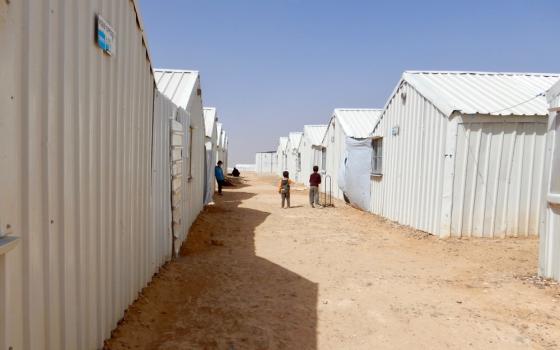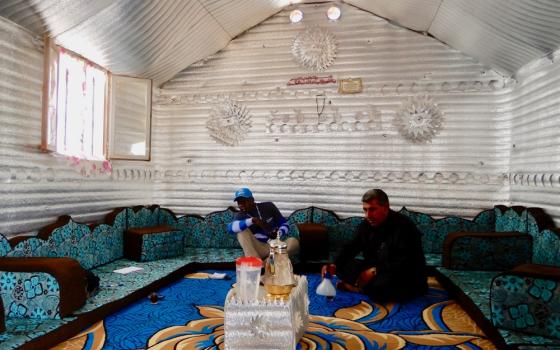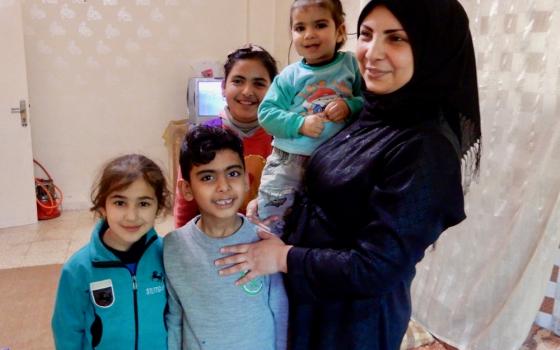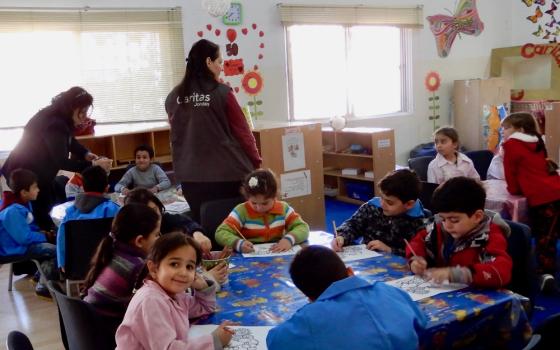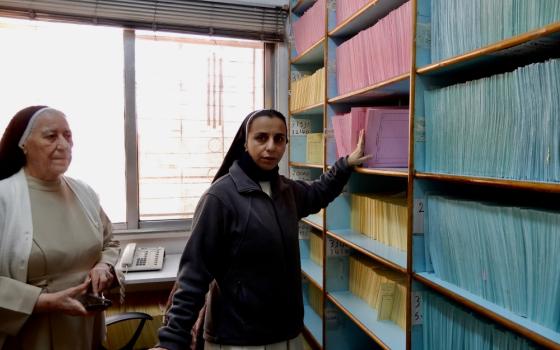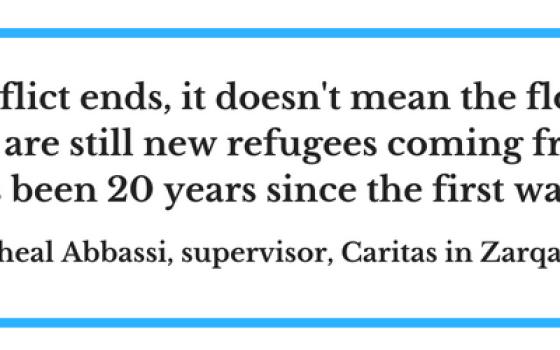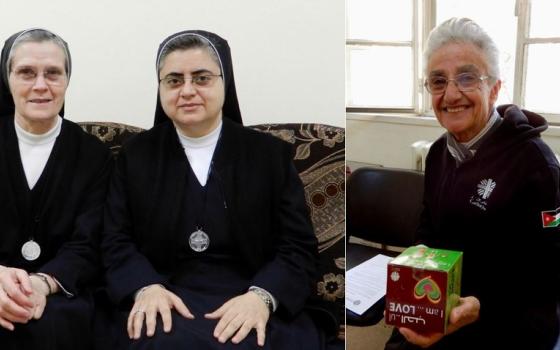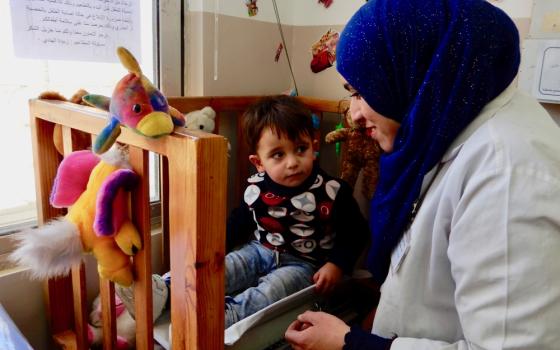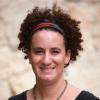Editor's note: More than 68 million people had been displaced from their homes because of factors such as war, threats from gangs, natural disasters, and lack of economic opportunities at the end of 2017, the highest number of displaced since the aftermath of World War II. Of those, the United Nations considered 25.4 million to be refugees: people forced to leave their countries because of persecution, war or violence.
Global Sisters Report is bringing a sharper focus to the plight of refugees through a special series, Seeking Refuge, which will follow the journeys refugees make: living in camps, seeking asylum, experiencing resettlement and integration, and, for some, being deported to a country they may only vaguely remember or that may still be dangerous.
Though not every refugee follows this exact pattern, these stages in the journey are emblematic for many — and at every stage, Catholic women religious are doing what they can to help.
______
Jordan's Azraq refugee camp is located in the desolate desert, two hours southeast of Amman. Without a tree in sight, everything in the camp is brown, coated by a desert dust so prevalent even the beige-tinged sky seems to hang low and close.
In perfect rows, three meters between each building, 10,479 corrugated metal huts break up the horizon.
Azraq Camp is the pride of the United Nations High Commissioner of Refugees (UNHCR). Usually, refugee camps are chaotic and messy, with desperate refugees building makeshift accommodations wherever they can. But Azraq is different. It is one of the world's first refugee camps planned, constructed and finished before the first refugees arrived: a refugee camp designed as carefully as a 1950s American subdivision.
Azraq's well-organized layout does have perks: Residents have easy access to health care, education, cash assistance and subsidized food at the World Food Project hangar, a cavernous wholesale supermarket. Around 35,000 people are registered as living in the camp that opened in May 2014.
Most Syrian refugees in Jordan do not live in places like Azraq. According to the U.N., 81 percent of refugees in Jordan live in urban areas, finding housing in cramped apartments, working informal jobs that pay in cash, doing their best to get by in the crowded streets of Amman and other cities.
Because the urban refugees are scattered around the city, they have much more difficulty obtaining comprehensive services. Although they also receive refugee identity cards and can get the same support as those in the camps, it is more logistically challenging to inform them of their rights and ensure they receive them.
While large international organizations provide services at the organized refugee camps, many urban refugees are falling through the cracks. As the war in Syria drags on and the refugee situation shows no sign of abating, sisters and Catholic organizations in Jordan are concentrating on aiding city refugees, trying their best to connect them to as many resources as they can muster, or just lending an empathetic ear.
A history of welcoming
Throughout history, Jordan's blend of traditional hospitality and political stability has made it the destination for wave after wave of refugees. First the Palestinians came, in 1948 and 1967, following wars with Israel. Today there are more than 2 million Palestinian refugees in Jordan who have full citizenship. Culturally, they still identify as refugees, though international organizations no longer consider them as such.
Iraqis and Kuwaitis came during the Gulf War in the 1990s, then the Iraqis came again in the early 2000s after the American invasion, and again in 2014 when the Islamic State group terrorized the country.
Since 2011, more than 655,000 Syrian refugees have streamed across the border, escaping an eight-year civil war. In the beginning of 2018, Jordan had 740,000 refugees, according to UNHCR
Jordan has a 16.5 percent unemployment rate, and the number of residents living under the national poverty line climbed, from 13 to 14 percent over the last decade, according to the World Bank.
The desert country of 10 million people is quickly running out of water and doesn't have the natural resources for the meteoric population growth resulting from the influx of refugees. According to U.N. population and refugee data, Jordan's rate of accepting Syrian refugees in the last decade would be equivalent to the United States adding more than 20 million into its total population. In fact, the U.S. has admitted only 21,205 Syrian refugees since 2002, U.S. State Department data shows.
Welcome to visit, but please don't stay
Like many other countries, Jordan severely limits the ability of refugees to work, in hopes that they will soon return to their home countries before getting too comfortable. The country reluctantly issued 46,000 work permits for refugees in 2017, but the vast majority of refugees cannot legally work. This thrusts them deeper into poverty, and makes them more dependent on international organizations.
Another part of Jordan's strategy to ensure refugees don't stay in their country is to assign them to live in the Azraq Refugee Camp. The desolate landscape, rudimentary accommodations, and sheer boredom make many residents consider the camp an "open air prison." Zaatari Refugee Camp, the larger and more well-known Syrian refugee camp in Jordan only a few miles from the border, has a freewheeling economy and a main drag named "Champs-Élysées," where enterprising Syrians have set up businesses from hair salons to bridal studios.
But in Azraq, the camp's U.N. directors tightly control every aspect of life. They decide who can run stores and where the public can gather. They are installing a cash benefit payment system that reads the iris of the eye, like something out of a science fiction movie. Refugees must obtain permission to leave the camp.
"Azraq is not a pop-up camp that people came and immediately settled," said Emanuel Kenyi, the local associate external relations and reporting officer for the UNHCR. Kenyi is originally from South Sudan but spent most of his life as a refugee in Uganda. "Azraq was planned for a year before the first people moved in. As Zaatari was getting filled up, they started planning Azraq before the refugees arrived."
Jordanian authorities are trying to convince urban refugees that life will be easier in the camp, so as to avoid situations where refugees assimilate into city life and decide to stay. Many refugees struggle to pay rent and feed their families in the cities, where services are patchwork and more difficult to access.
Stepping in to fill the gaps
Urban refugees are spread out and busy trying to cobble together a survival, requiring more personalized solutions.
In many ways, sisters are uniquely positioned to provide this kind of case-by-case assistance, because they are integrated with the community and have a familiarity with Catholic organizations providing aid. In Zarqa, a suburb of Amman, Dominican Sisters of St. Catherine of Siena run the Pontifical Mission Mother of Mercy Clinic, which provides prenatal care and vaccines for more than 1,000 people every month.
The clinic opened in 1989 next to a Palestinian refugee camp with the goal of helping the displaced. Today, the clinic provides heavily subsidized medical care to refugees and foreign workers from Afghanistan, Chechnya, Syria, Egypt, Iraq and Bangladesh, in addition to impoverished Jordanians.
The Dominican sisters are themselves refugees from Iraq, forced to flee in 2014 when Islamic State militants attacked the area of Nineveh. The congregation lost 33 convents, three schools and six Montessori kindergartens in bombings across Iraq, according to Sr. Habiba Toma Binham. Binham said the refugees they serve know the sisters are intimately familiar with the pain of losing a home and facing an uncertain future.
The clinic frequently treats psychiatric diseases and psychosomatic issues, when refugees complain of pain that doesn't seem to have a biological explanation.
"They are worried about their lives and future," said Rasha Altoum, a social worker at the clinic. Altoum is a third-generation Palestinian refugee. "They come here to be comfortable, because we give them the chance to talk freely without fear."
Altoum recalled a young Iraqi girl who came to the clinic, eyes tightly squeezed shut, telling the sisters she had gone blind. "Her family was always thinking about leaving [Jordan to go back to Iraq], and she was scared so she reacted by kind of going blind," she said. "So we let her speak about what she's feeling. We asked, 'What are you afraid of? What can we talk about?'"
'We were all once refugees'
Many sisters find commonalities among the refugees' challenges, regardless of where people have come from. One is an insistence on getting immediate help, stemming from overall uncertainty and instability.
"People in need are always angry," said Soheal Abbassi, the supervisor for Caritas in Zarqa. "They have their needs, their kids' needs, they have to pay the rent, they are really worried and scared. We tell them, 'We are trying to help you, but nothing is for sure.'"
Caritas runs 22 centers across Jordan, focusing on health and education. Caritas also provides remedial tutoring service and runs "catch-up school," an afterschool framework for Syrian children who couldn't gain admission to government schools because of severe over-enrollment.
Abbassi said Jordanians know the situation for refugees is dire and are trying to keep the welcome mat unfurled. "There's some, maybe not anger, but they are wondering, 'Why isn't the help going to us, why are all the non-profit organizations working with refugees,' " Abbassi said. Jordan requires NGOs working with refugees to dedicate 30 percent of their programming to Jordanians in need, but there is still some resentment.
"There's also less assistance coming now," Abbassi said, pointing out that international donors have tired of the Syrian conflict. "So there's less for refugees and less for Jordanians. So now everyone is angry because there's less for everyone."
And Jordanians know the current situation is probably their new reality for the foreseeable future. "Last year, people were saying it will be calm in Syria, but it's still not safe to go back," said Abbassi. "We know it will be at least two to three years until everything is safe."
Even when the violent conflict is over, that doesn't necessarily mean the flow of refugees will stop, as survivors find it is impossible to make a living in the shattered country. "Today, there are still new refugees coming from Iraq, and it's been 20 years since the first war," said Abbassi.
As sisters and international organizations try to create a safety net for urban refugees, they also point out that their most important role might be just to listen.
The Hashmi neighborhood is a rough corner of Amman, with about 200 Iraqi refugee families as well as Egyptians who work illegally in construction. Sr. Carmela del Barco, a Dorotea sister originally from Italy who has been in Jordan since 1975, said the arrival of a wave of Iraqi refugees four years ago turned the sisters' convent into an informal counseling center.
The sisters' official ministry in Hashmi is running a school for 500 students from first through 10th grade as well as leading catechism and religious discussion groups. But a large part of their time is also sitting in their living room or visiting parishioners in their homes, listening to their stories and trying to help them the best they can.
"We do small stopgap measures," said Sr. Rania Khoury, one of the three Dorotea sisters, known formally as the Sisters of St. Dorothy, Daughters of the Sacred Hearts of Jesus and Mary, in Hashmi. "They like to come here to speak, it's a very important spot for them. We are near the church. … We can't do everything, but we try to help families with sick babies and children."
On some months, international donations allow them to provide diapers and formula for 150 babies or help a family pay for a medical test.
"When we have nothing, we try to listen so they can feel better," said Khoury. "If you just listen so they can express everything, they feel better than before. They leave here feeling calmer."
The Sisters of Sr. Dorothy used to have a presence in Syria, but after a sister was killed in a 2013 bombing, the congregation left.
The most important thing
Some problems are impossible for the sisters to solve, so they can only provide emotional support.
"Just being with refugees, that is the mission," said Sr. Hanne Saad, a Franciscan Missionary of Mary who volunteers with Caritas in Amman and works mainly with Syrian and Iraqi refugees. "We don't need to talk, we need to listen."
Saad said the biggest challenge is the refugees feeling helpless and depressed because they cannot work. "They have the energy to work but they can't," she said. Those are the kinds of problems the sisters can't solve. Still, they try to strengthen the refugees. "We have hope in life, because if you don't have hope, you don't have life," she said.
That is the hope that Hanaa Abdullah, a tailoring teacher who fled a village near Deir ez-Zor, in eastern Syria, clings to every day. She lived in Azraq camp with her husband and three children for seven months in 2016 before they were able to secure a permit to live outside the camp.
"The first months in the camp, I was just sitting and crying," Abdullah said. "When I wanted to get out of the camp, I got help. I'm happy to be out. It's better for the children's psychology, education. And life is better here."
After moving to Madaba, a large city south of Amman, the family had new challenges: how to pay for rent and electricity, how to enroll the children in school, how to collect the cash assistance awarded to refugees, where to get health care. She gets text messages irregularly from the U.N. refugee agency.
"I try to be as strong as I can in order to be in a better situation," she said. Her daughter, Joud, 10, is still traumatized from the plane bombings that raked their hometown. "When we first got here, whenever Joud would hear a plane she would put her head in my lap and start shaking, covering her ears," said Abdullah. Now, Joud is less scared of planes, though the family is still trying to adjust to their new lives in Jordan.
"The biggest happy story for us is that we're together as a family," Abdullah said. "The rest is less important."
[Melanie Lidman is Middle East and Africa correspondent for Global Sisters Report based in Israel.]
Next in this series: Sisters support those seeking asylum in the United States who face multiple challenges to thrive in their new country
